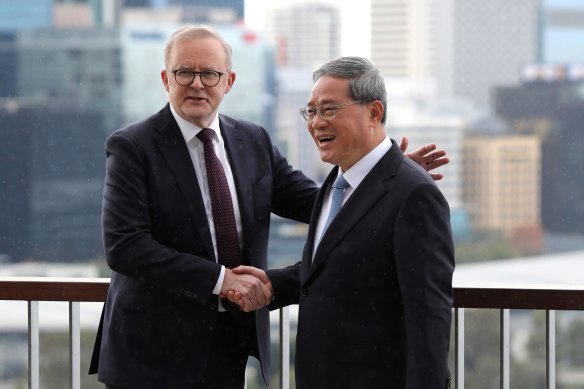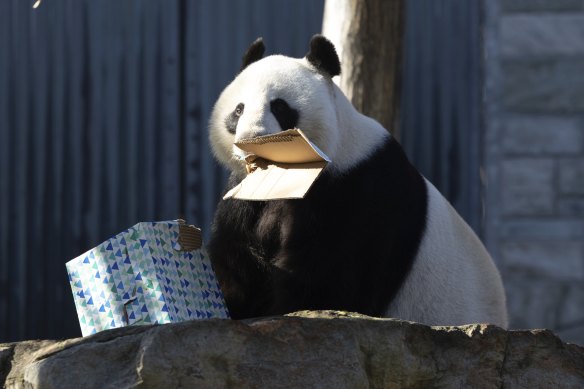- Analysis
- World
- Asia
- China relations
Pandas can’t paper over Australia’s differences with China
By Lisa Visentin
Chinese Premier Li Qiang’s 747 jet had left Perth bound for Malaysia on Tuesday afternoon when the Australian government released a statement expressing “grave concerns” at China’s latest act of “dangerous and illegal” behaviour in the South China Sea.
It was a shot of realism at the end of a four-day diplomatic blitz of Australia by Xi Jinping’s second-in-command, puncturing any lingering giddiness at the panda gift-giving in Adelaide and putting paid to Li’s quixotic appeal for the two countries to “shelve” their differences.

Prime Minister Anthony Albanese and Premier Li Qiang in Perth this week.Credit: Bloomberg
Prime Minister Anthony Albanese had been hosting Li in Perth when news reports gathered steam that a Chinese Coast Guard vessel had rammed a Philippines ship near the hotly contested Spratly Islands the previous day, resulting in a Filipino sailor’s finger being severed and several crew members suffering minor injuries.
The incident, which follows other dangerous confrontations by Chinese military vessels and jets towards the Australian Navy, is part of a pattern of aggressive behaviour by China that the US and her allies fear is one catastrophic clash away from dragging the region into a conflict.
Albanese voiced Australia’s concerns to the premier in private. The official public statement, quietly posted to the Department of Foreign Affairs website, would land after Li’s departure, many hours after the incident occurred.
Li’s visit, the first by a Chinese premier in seven years, is a testament to the success of the quiet diplomacy model which has underpinned the efforts by Albanese and Foreign Minister Penny Wong to stabilise Australia’s relationship with the volatile superpower.
But the visit also exposed its limitations, inviting fresh questions about whether this “stabilisation” approach has run its course and now comes at the expense of a more forceful, public defence of Australia’s national interest.
Dr Benjamin Herscovitch, a researcher in Australia-China relations at the Australian National University, said after years of frosty relations between the two countries, the fact the visit occurred was a “win” in and of itself. But at the same time, the Albanese government’s decision to dial back Australia’s rhetoric critical of China since taking office and even engage in a policy self-censorship were clear victories for Beijing.
“There is a risk in the long term of the Albanese government making compromises that are problematic in terms of the Australian national interests and in terms of ethics,” he says.
“That’s a recipe for effectively ceding a significant part of your sovereign decision-making and outsourcing that to Beijing’s sensitivities.”

Protesters and pro-China supporters railled outside Parliament House this week as Prime Minister Anthony Albanese hosted Chinese Premier Li Qiang.Credit: Alex Ellinghausen
One example of this, he says, is the fact that Australia has not followed the US, EU and UK in sanctioning Chinese companies supplying Russia with dual-use technologies for use in its illegal invasion of Ukraine.
“It’s a really morally questionable position for the Albanese government to take”, Herscovitch says, and one that undermines Australia’s security as Beijing grows increasingly belligerent in asserting its territorial claims to Taiwan and in the East and South China Sea.
Despite the diplomatic platitudes, the deep fissures in the Australia-China relationship when it comes to competing worldviews, values and systems of government were plain to see. At every stop on Li’s visit – Adelaide, Canberra, and Perth – protesters campaigned against China’s human rights abuses against Muslim Uyghur minority groups and in Tibet, as well as Beijing’s brutal crackdown on dissent in Hong Kong.
Inside Parliament House, the move by Chinese diplomats to block journalist and former detainee Cheng Lei from the view of cameras at a signing ceremony sparked a public outcry, with many seeing the incident as emblematic of the Chinese state’s brazen disregard for Australia’s democratic institutions even when guests on foreign soil.

Wang Wang, one of the pandas at Adelaide Zoo.Credit: Alex Ellinghausen
Over the course of the four days, Wong and Albanese assiduously repeated the “co-operate where we can, disagree where we must” mantra that has guided the government’s relationship-repair efforts.
Unquestionably, this approach has borne fruit over the past two years, most notably on the trade front. Beijing has gradually lifted $20 billion in coercive sanctions it slapped on a dozen Australian exports in 2020 in retaliation for the former Coalition government’s more strident and public criticism of China and policy measures such as the Huawei ban and foreign interference laws.
For the long-suffering lobster industry, Li’s visit didn’t bring confirmation of the lifting of this last remaining export ban, but there were announcements about renewed military-to-military communications albeit with little detail, visa-free travel by Australians to China, and of course, two new pandas for Adelaide Zoo.
“Dialogue is how we manage differences,” Albanese told the press in Canberra, as he confirmed he raised with Li the case of Chinese-Australian academic Yang Hengjun, who is facing a suspended death sentence, and other human rights concerns, though he did not go into detail.
Restored communications is a theme the government has hammered home at every turn as it seeks to remind the public of the ministerial-level communication blackout between China and Australia under the former Morrison government.
Australian Strategic Policy Institute executive director Justin Bassi had a front-row seat to the nadir of the Australia-China relationship in the Coalition era as chief of staff to former foreign minister Marise Payne.
He said that while the resumption of high-level engagement was important, Li’s visit had added to a growing sense that dialogue was an end in itself. It had the effect of putting the two countries’ “differences” on equal footing.
“Topics such as illegal behaviour in the South China Sea, the arbitrary detention of Australians such as Dr Yang, cyberattacks and foreign interference, none of these are matters of opinion that both sides should be able to air their differences on,” Bassi says.
“That’s the risk of the quiet diplomacy approach ... not explaining to the public what the positions are...is dialogue on Beijing’s terms, not dialogue on Australia’s terms.”
Deciding when, where and how forcefully to air these differences is a tricky diplomatic calculation.
Lowy Institute senior fellow Richard McGregor said that while the stabilisation approach had its limits, focusing on the diplomatic niceties that Albanese used with Li was the wrong barometer for assessing Australia’s handling of the relationship.
“Albanese is not Australia’s sole voice on China,” he says.
“The fundamental differences between Australia and China were never going to be solved by this trip ... It may be a fantasy that we can manage differences in the long term, but there is nothing wrong with trying to do so.”
He pointed to Richard Marles’ speech at the Shangri-La security dialogue in Singapore last month, where the defence minister called out China’s “unsafe” confrontations with Australian naval forces, and its aggression in the South China Sea and Taiwan as a threat to global stability.
Meanwhile, as Li arrived to a red carpet welcome in Kuala Lumpur, Wong touched down in Port Moresby to lead a high-powered delegation of six Australian ministers to Papua New Guinea. It is part of a full-court press by Australia to counter China’s growing influence in the Pacific.
Across a slew of media interviews, she made clear the threat China posed in Australia’s backyard.
“We are in a permanent contest in the Pacific,” she said.
Get a note directly from our foreign correspondents on what’s making headlines around the world. Sign up for the weekly What in the World newsletter here.